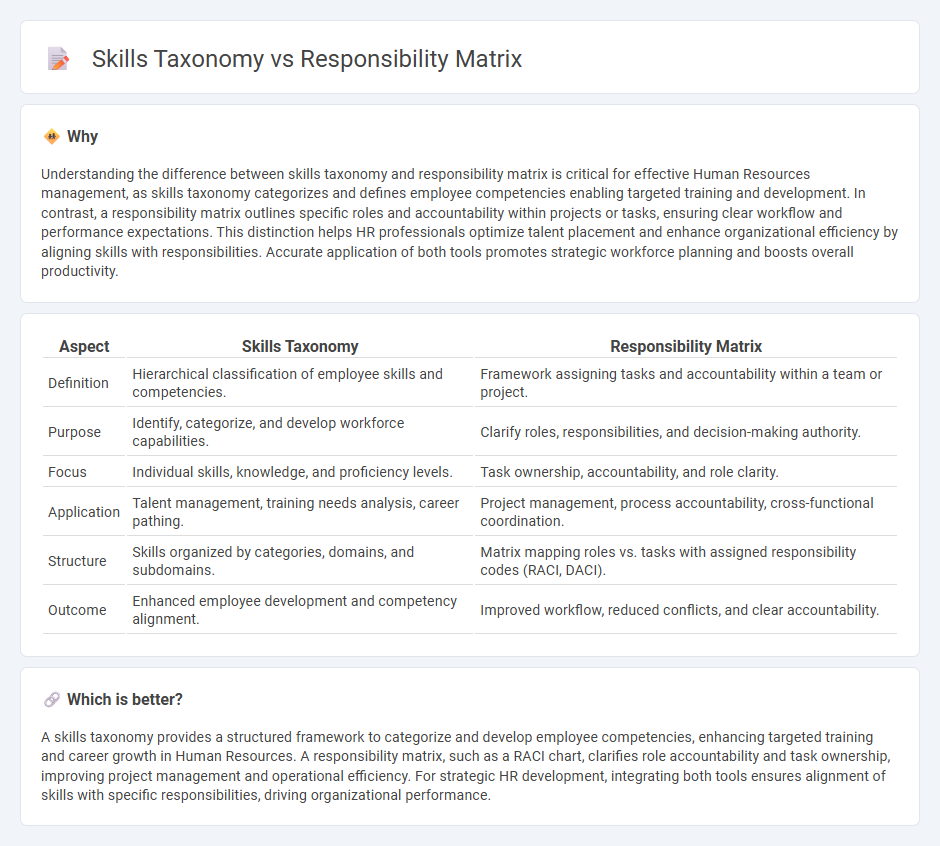
Skills taxonomy organizes employee abilities into categorized hierarchies, enabling precise talent management and targeted training programs. Responsibility matrix defines specific roles and accountability in projects, clarifying who is responsible, accountable, consulted, and informed for every task. Explore how aligning skills taxonomy with responsibility matrix enhances workforce efficiency and project success.
Why it is important
Understanding the difference between skills taxonomy and responsibility matrix is critical for effective Human Resources management, as skills taxonomy categorizes and defines employee competencies enabling targeted training and development. In contrast, a responsibility matrix outlines specific roles and accountability within projects or tasks, ensuring clear workflow and performance expectations. This distinction helps HR professionals optimize talent placement and enhance organizational efficiency by aligning skills with responsibilities. Accurate application of both tools promotes strategic workforce planning and boosts overall productivity.
Comparison Table
| Aspect | Skills Taxonomy | Responsibility Matrix |
|---|---|---|
| Definition | Hierarchical classification of employee skills and competencies. | Framework assigning tasks and accountability within a team or project. |
| Purpose | Identify, categorize, and develop workforce capabilities. | Clarify roles, responsibilities, and decision-making authority. |
| Focus | Individual skills, knowledge, and proficiency levels. | Task ownership, accountability, and role clarity. |
| Application | Talent management, training needs analysis, career pathing. | Project management, process accountability, cross-functional coordination. |
| Structure | Skills organized by categories, domains, and subdomains. | Matrix mapping roles vs. tasks with assigned responsibility codes (RACI, DACI). |
| Outcome | Enhanced employee development and competency alignment. | Improved workflow, reduced conflicts, and clear accountability. |
Which is better?
A skills taxonomy provides a structured framework to categorize and develop employee competencies, enhancing targeted training and career growth in Human Resources. A responsibility matrix, such as a RACI chart, clarifies role accountability and task ownership, improving project management and operational efficiency. For strategic HR development, integrating both tools ensures alignment of skills with specific responsibilities, driving organizational performance.
Connection
Skills taxonomy organizes and categorizes employee competencies, providing a structured framework for identifying expertise within an organization. The responsibility matrix maps tasks and accountability to specific roles, ensuring clarity in job functions and expectations. Integrating skills taxonomy with the responsibility matrix enhances talent management by aligning individual capabilities with corresponding responsibilities for optimal workforce performance.
Key Terms
**Responsibility Matrix:**
A Responsibility Matrix clearly defines project roles and task ownership, ensuring accountability and streamlined workflow management across teams. It visually maps who is Responsible, Accountable, Consulted, and Informed (RACI), optimizing communication and decision-making processes. Discover how a Responsibility Matrix can enhance your project execution and team collaboration.
RACI
A Responsibility Matrix, especially the RACI model (Responsible, Accountable, Consulted, Informed), clarifies roles and responsibilities in project management, ensuring clear accountability and communication. Skills Taxonomy categorizes and defines the competencies required for various roles but lacks the direct assignment of task accountability found in RACI. Explore more to understand how integrating RACI with skills taxonomy enhances both performance and project clarity.
Accountability
A responsibility matrix clearly defines accountability by assigning specific tasks and decision-making authority to individuals or roles, ensuring clarity in who is responsible for what. Skills taxonomy categorizes and organizes the capabilities within an organization but does not directly address accountability. To understand how these frameworks enhance organizational efficiency, explore the distinctions between responsibility matrix and skills taxonomy further.
Source and External Links
How to Make a Responsibility Assignment Matrix ... - A responsibility assignment matrix (RAM) is a project management chart that identifies people and organizations involved in a project and clearly assigns roles using categories like responsible, accountable, consulted, and informed to each task or deliverable.
RACI Matrix: Responsibility Assignment Matrix Guide - The RACI matrix is a popular type of responsibility assignment matrix defining four key roles: Responsible (those doing the work), Accountable (those who approve deliverables), Consulted (those who provide input), and Informed (those kept updated).
Responsibility assignment matrix - Also called RACI matrix or linear responsibility chart, the responsibility assignment matrix clarifies roles and responsibilities across projects or processes by mapping roles to tasks, typically using the Responsible, Accountable, Consulted, and Informed categories, to improve collaboration and accountability.
 dowidth.com
dowidth.com